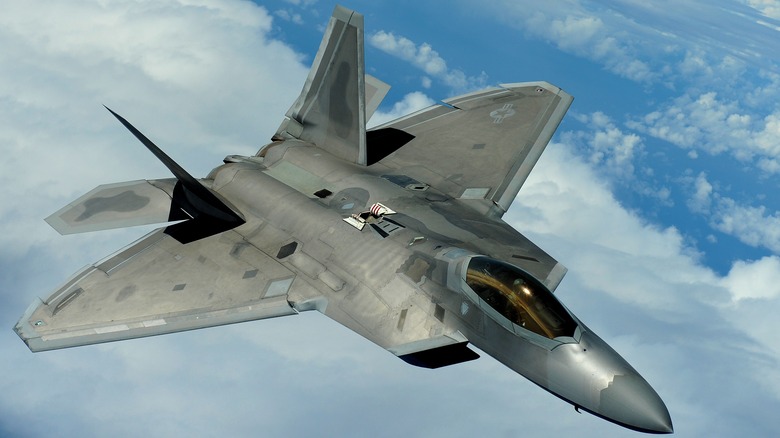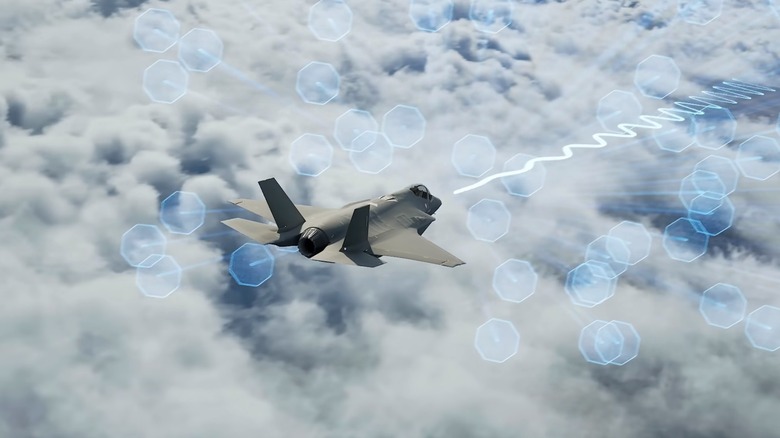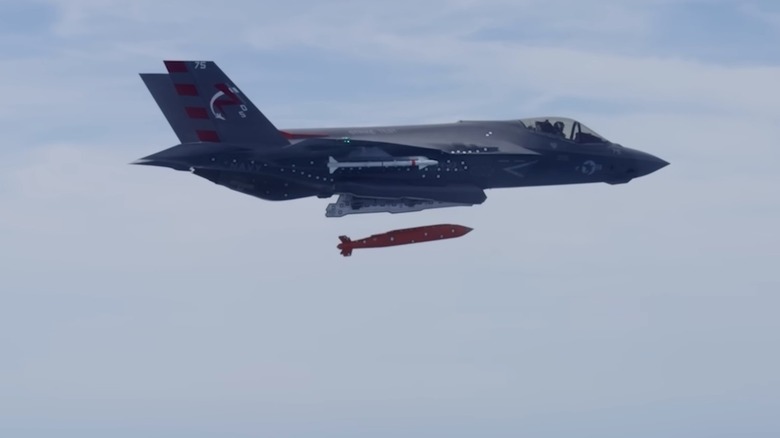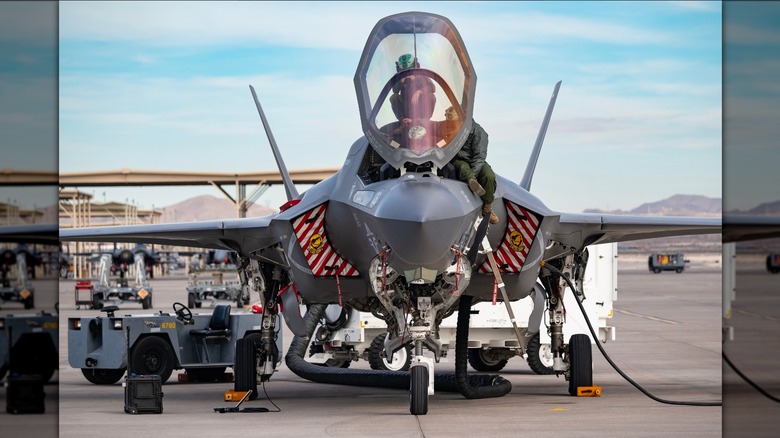The Biggest Strengths And Weaknesses Of The F-35 Fighter Jet
Undoubtedly, one of the most impressive and imposing fighter jets from the crop of 5th generation aircraft is the F-35 Lightning II. There are three variants of the F-35: the F-35A, F-35B, and F-35C, each with distinct features of its own. One of the most striking capabilities of the F-35B is its ability to reorientate thrust downward to allow hovering, landing vertically, and very short take-offs.
With a single turbofan engine that generates 43,000 pounds of thrust, the F-35 surpasses the power of other models like the F/A-18 Super Hornet with two engines. Although the F-35 is superior in terms of how much thrust its single engine produces, the F/A-18 is faster, but that doesn't tell the whole story. The F-35 benefits from enhanced stealth, making it far more effective against aerial targets than any previous generation fighter.
While there are several notable features of the F-35, such as its advanced sensors, stealth coating, and cutting-edge integrated technology, there are some drawbacks. There have been reports of various issues with the jet, including the recently publicized incident where the U.S. Military lost a $130m F-35 Lightning in South Carolina. Problems with the fighter's Autonomic Logistics Information System (ALIS) and the various automated modes that drive the jet have resulted in it being available for duty a mere 51% of the time. So, in what areas does this approximately $130 million aircraft excel, and what holds it back from its true potential?
A huge step forward in technology
The fighter jets labeled 5th generation are all equally extraordinary, with capabilities far beyond those of previous models. One of the hallmarks of this latest crop of aircraft is their state-of-the-art stealth abilities, and the F-35 is no exception. The F-35's exterior is coated in a material that successfully absorbs radar or radio waves that enemy forces use to identify unknown aerial threats. With enhanced stealth, the F-35 can target the opposition before it is even detected.
With what's considered the most leading-edge suite of sensors ever incorporated into a fighter aircraft, the F-35 sports some remarkable features. For example, there are a series of infrared cameras arranged around the jet pointing in different directions. This camera system then creates a 360-degree video feed that the pilot can display across the highly advanced Helmet Mounted Display System (HMDS). When the pilot uses the video feed from the cameras, they can essentially see through the plane itself with no obstructions for incredible visibility.
The pilots also have access to a touchscreen system in the cockpit that is described as side-by-side tablets. These touchscreens are not only intuitive, but they allow each pilot to customize the display and choose how they'd like to arrange the data for an individualized experience.
Potent weapon options
When evaluating the F-35, it's impossible not to point out its advantages in terms of aerial ordnance. With a weapons payload of up to 18,000 pounds, this aircraft can carry a host of destructive options, including air-to-air missiles, a hidden 25mm Gatling gun(F-35A), external canon (F-35B and F-35C), and several bombs. This fighter has a hidden internal bay, which can hold nearly 6,000 pounds of obliterating ordinance.
Even more impressive is the F-35's remarkable versatility, which allows it to adjust to a range of missions. A stealth-oriented loadout for surveillance and recon is much different than an F-35 equipped for a bombing run. With internal weapon storage and ordnance along the wings, this fighter can accommodate armaments weighing 22,000 pounds in total.
As if that wasn't enough, the F-35 has also become the first-ever stealth jet fighter sanctioned to carry a nuclear bomb. To be precise, the F-35 can carry two B61-12 nuclear gravity bombs.
Aspects of the F-35 cause concern
The astounding leap forward in technology with the F-35 is also responsible for some of its problems. Like a double-edged sword, the number of autonomous systems meant to set the aircraft apart has raised concerns about its ability to consistently perform in the field. The logistics system, which accounts for all the components of each F-35, has lost connection to servers before forcing backup contingencies in place.
While some praise the aircraft's autonomous systems as requiring little from the pilot traveling to and from the mission area, others are more skeptical. According to the U.S. military, the F-35 still isn't achieving the set standards for reliable operation and maintenance. One of the primary causes of serious breakdowns involves software malfunctions, which require extended in-depth assessments, according to ongoing evaluation reports. Fortunately, there continues to be a strong effort toward eliminating these issues and ironing out the problems with this advanced fighter.
One of the most significant concerns, beyond software issues and maintenance, is the high cost of the F-35 program. Much to taxpayers' dismay, this aircraft is the costliest military project in history and on track to exceed well over 1 trillion dollars — well past its initial budget estimates. Some are calling on both the Department of Defense and Congress to come up with a solution to the ever-ballooning overhead of the F-35 venture.



